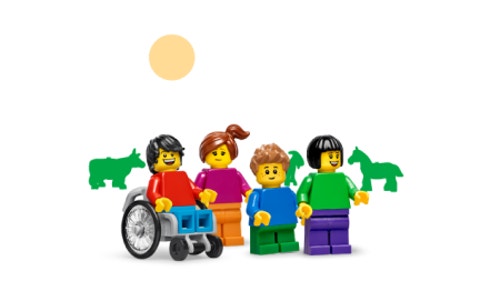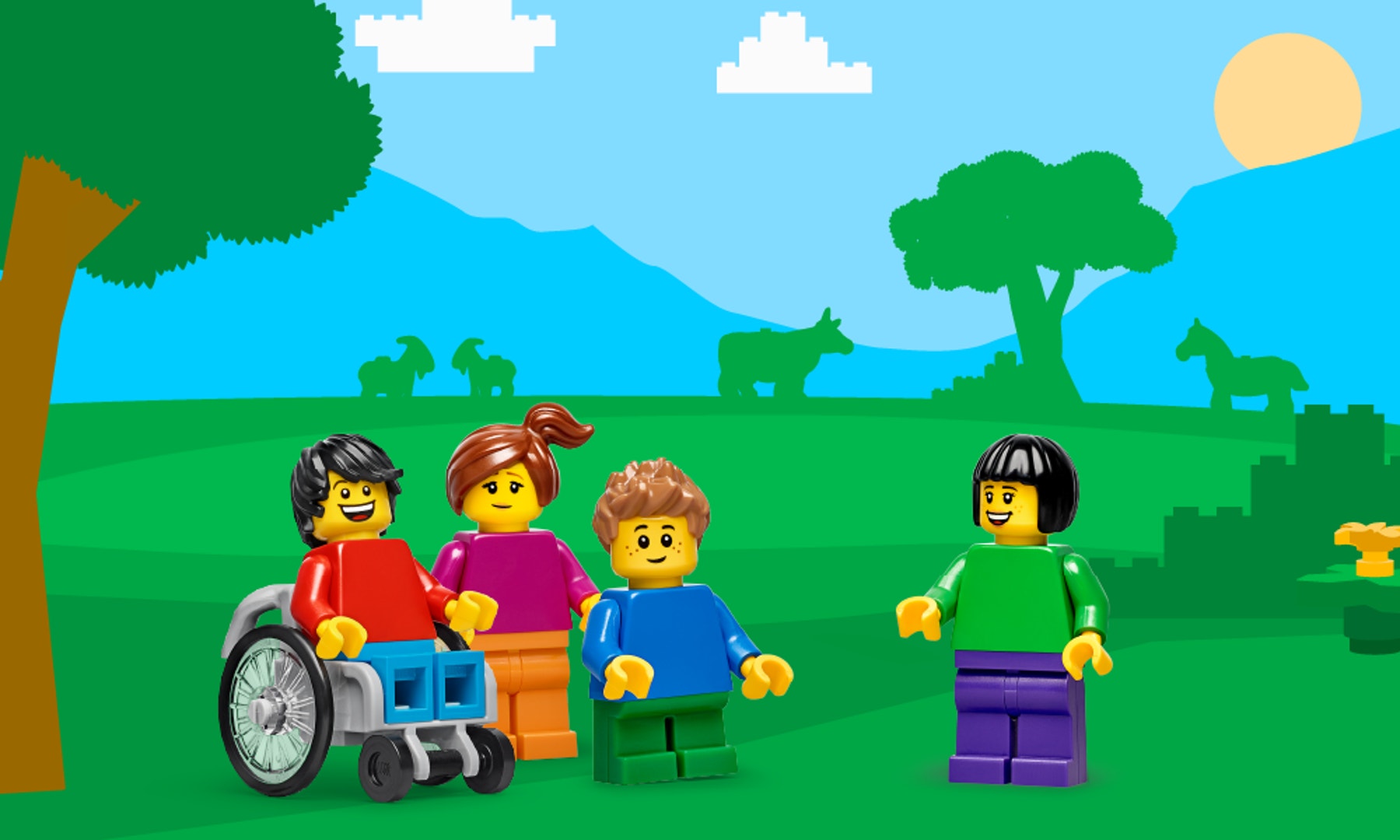Energy Flow
Daniel, Maria, Leo, and Sofie know that plants use sunlight to grow bigger. Do animals also need it to grow bigger? Build a model to show the team the relationship between sunlight and animal growth.

Prepare
(NOTE: This lesson contains a Part A and a Part B. Both are important to access the full learning of the standard. If time is limited, review both parts to choose elements that meet your students’ needs.)
In this lesson, students will build a model that shows the relationship between the sun’s light and animal growth. Encourage students to design and build their own idea and reinforce that there is no single correct model .
- Science Background - Energy Flow:
- Energy from the sun is stored in the foods animals eat (for example, when they eat plants that have converted sunlight into stored chemical energy).
- Plant-eating animals include herbivores (only plant-eating) and omnivores (plant- and meat-eating). Carnivores eat only meat. Guide students away from showing carnivores eating plants.
- Build Prior Knowledge - Energy Flow. Using your core science materials, share information, images, and definitions:
- Energy is present in sunlight, plants, and animals.
- Plants capture energy from the sun and use it for their growth. Animals that eat those plants get the stored energy.
- Some animals eat only plants (herbivores), some only eat other animals (carnivores), and some eat both plants and animals (omnivores).
- Animals use energy stored in their food for life functions like growth, movement, and staying warm.
- (Optional) If your students are familiar with the terms herbivores, carnivores, and omnivores, briefly review and reinforce in the lesson, i.e., the animals eating plants in the model should be herbivores or omnivores.
- Key vocabulary: energy, flow, (optional—herbivores, carnivores, omnivores)
- Building and Programming Experience: Review the suggestions in the Unit Plan. For this lesson, you may also want to:
- Reinforce with all the tutorials in the SPIKE App Start menu.
- Try one or more of the other lessons in the Science We Cannot See unit to gain more building experience and get familiar with Word Blocks in the SPIKE App.
PART A (45 Minutes)
Engage
(Whole Class, 10 minutes)

Introduce the story’s main character(s) and the first challenge: Daniel, Maria, Leo, and Sofie know that plants use sunlight to grow bigger. Do animals also need it to grow bigger? Build a model to show the team the relationship between sunlight and animal growth.
THINK—Facilitate a brief discussion about the lesson topic(s), using the story picture if you wish:
- Where do plants get the energy that they need to grow? (from the sun)
- Where do animals get the energy that they need?(from eating plants or other animals that ate plants)
- What do animals use that energy for? (to grow, move, and heal body parts; if warm-blooded, to maintain body warmth)
- Explain to students: Energy changes form as it flows from the sun to plants and animals. For example, the energy in sunlight is converted to stored chemical energy in plants.
Distribute a SPIKE™ Essential Set and device to each group.
Explore
(Small Groups, 25 minutes)
- Review that students may design and build any model they wish in this open-project lesson. Reinforce that there is no single correct model.
- Have students:
- Explore their design ideas visually, such as by sketching.
- Begin to BUILD and PROGRAM a model to help the team learn about the relationship between the sun’s light and animal growth. Models should show the flow of energy and demonstrate how animals get and use energy from it.
- Facilitate brainstorming about ways to use LEGO elements to represent parts of the model (e.g., use the light matrix to represent the sun or use the motor to make a LEGO animal move and represent its energy use).
- Halfway through work time, have students exchange ideas using a familiar classroom routine and then update their models with inspiration from sharing.
Explain
(Whole Class, 10 minutes)
Gather students for sharing.
Have each group share and explain its model and sketches, identifying parts still in progress that show:
Where energy is present (e.g., in the sun, plants, and animals)
How energy flows from the sun to plants and animals
How animal(s) get and use that energy
Elicit sharing and suggestions about parts of the model where groups are struggling.
If you wish to continue in Part B—Explain, have students keep their models intact or allow time for rebuilding.
PART B (45 minutes)
Explain
(Whole Class, 10 minutes)
- Repeat the steps from Part A—Explain to support additional sharing, brainstorming, and inspiration for continued model building.
Elaborate
(Whole Class, 30 minutes)
Have students:
- (10 min) Continue to BUILD and PROGRAM, incorporating inspiration from the sharing activity.
- (15 min) Use their completed models to share learning with the class and answer the question in the lesson challenge: Do animals also need sunlight to grow bigger? (Not directly. However, animals do get the energy they need by eating plants that got their energy from the sun.)
(5 min) Invite students to share knowledge, ideas, or skills that
- Helped them complete the challenge.
- They learned while building.
Have students clean up the sets and work areas.
Evaluate
(Whole Class, 5 minutes)
- Ask guiding questions to elicit students’ thinking and their decisions while ideating, building, and programming.
Observation Checklist
Review the learning objectives (Teacher Support box).
Share specific student responses and behaviors at different levels of mastery.
Use the checklist to observe students’ progress:
- Their models accurately show that plants capture energy from the sun, which flows to the animals that eat the plants.
- Their explanation accurately describes that the energy in animals’ food was once energy from the sun, even if it has changed form.
- They explain at least one way that animals use the energy from food (for growth or motion or to maintain body warmth).
Self-Assessment
Have each student choose the brick that they feel best represents their performance。
- Blue brick: I think I can follow instructions to create a program.
- Yellow brick: I can follow instructions to create a program.
- Green brick: I can follow instructions to create a program, and I can help a friend do it too.
Peer-Feedback
In their small groups, have your students discuss their experiences working together.
Encourage them to use statements like these:
- I liked it when you…
- I’d like to hear more about how you…
Differentiation
Simplify this lesson by:
- Assigning students a familiar plant-eating animal to use in the model, such as a rabbit or a horse.
Increase the difficulty by:
- Having students add an additional energy flow to their model by including carnivores, which eat herbivores.
Extension
- Have students research a way that humans use energy from the sun to meet their needs, such as solar panels to make electricity or passive solar design to warm their homes.
If facilitated, this will extend beyond the 45-minute lesson.
Language Arts: CCSS.ELA-LITERACY.W.5.7
Teacher Support
Students will:
- Create a model that accurately shows the flow of energy from sunlight to plants and then to animals.
- Use their model to describe how animals get and use energy from the sun.
- Use their model to explain that energy in animals’ food was once energy from the sun.
(one for every two students)
- LEGO® Education SPIKE™ Essential Set
- Device with the LEGO Education SPIKE App installed
Meet the team: Minifigure Bios
- 5-PS3-1: Use models to describe that energy in animals’ food (used for body repair, growth, motion, and to maintain body warmth) was once energy from the sun.
- CSTA 1B-AP-15
- NGSS 3-5-ETS1-1
- ISTE 1.4.c
- CCSS.ELA-LITERACY.SL.5.1
- CCSS.MATH.CONTENT.5.MD.B.2
Language Arts Extension
- CCSS.ELA-LITERACY.W.5.7